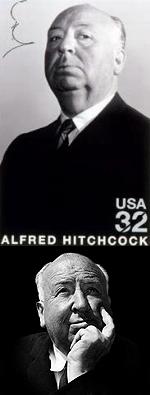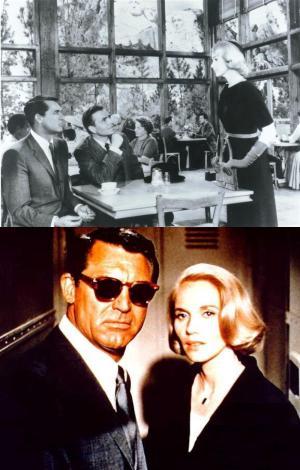|
 Dyed
in the wool movie fans likely have seen all the great films they know or have heard something about. Even the most casual fan knows and
appreciates Alfred Hitchcock's three most famous films: Psycho,
North by Northwest and The Birds. These three
masterpieces were made consecutively near the end of Hitchcock's brilliant career. But he made fifty-one other movies over a span of five
decades. Not all are masterpieces. They range from breathtaking to annoying. Facing rows of DVDs in the "Hitchcock" section can
cause sensory overload... so many choices, so many opportunities to skip over the classics and choose one of the dogs. With that in mind,
here is my list of the ten "next best" Hitchcock films to rent after you've enjoyed the famous three. Dyed
in the wool movie fans likely have seen all the great films they know or have heard something about. Even the most casual fan knows and
appreciates Alfred Hitchcock's three most famous films: Psycho,
North by Northwest and The Birds. These three
masterpieces were made consecutively near the end of Hitchcock's brilliant career. But he made fifty-one other movies over a span of five
decades. Not all are masterpieces. They range from breathtaking to annoying. Facing rows of DVDs in the "Hitchcock" section can
cause sensory overload... so many choices, so many opportunities to skip over the classics and choose one of the dogs. With that in mind,
here is my list of the ten "next best" Hitchcock films to rent after you've enjoyed the famous three.
1) Rear Window, 1954. Though too claustrophobic to equal his best movies, Rear Window nails all the themes that reoccur throughout
Hitchcock's work. As Jimmy Stewart unravels a mystery, much of the film is without dialogue. Between the intriguing camera shots and
Stewart's facial expressions, the audience must deduce for themselves what is going on.
2) Strangers on a Train, 1951. Alfred Hitchcock believed in a film device called the McGuffin. A McGuffin is the thing the characters
in the movie care about, but we as the audience ignore. The McGuffin is what sets the story in motion. Psycho's McGuffin is Janet Leigh
stealing $50,000 from work. Strangers' McGuffin may be the best ever conceived for a film. Robert Walker is unforgettable.
3) Foreign Correspondent, 1940. All Alfred Hitchcock films made during World War II are a bit flawed today by the extreme hysteria that
was a natural reaction then. All, that is, except Foreign Correspondent. It features his most three-dimensional villain of this period and ends
with an impassioned call to patriotism. If nothing else, we are shown how heroes are made out of the most unlikely candidates. Also, it'd be
years before Hitchcock had this much fun again.
 4)
The 39 Steps, 1935. In the 1926's The Lodger, Hitchcock first presented his familiar predicament: an innocent man falsely
accused of a crime. The 39 Steps has the twist of being about an innocent man falsely accused of being a spy. Loaded with memorable
scenes and fun bantering between Robert Donat and Madeleine Carroll, this film features one of Hitchcock's most intriguing stories. 4)
The 39 Steps, 1935. In the 1926's The Lodger, Hitchcock first presented his familiar predicament: an innocent man falsely
accused of a crime. The 39 Steps has the twist of being about an innocent man falsely accused of being a spy. Loaded with memorable
scenes and fun bantering between Robert Donat and Madeleine Carroll, this film features one of Hitchcock's most intriguing stories.
While flawed by some incomprehensible British dialogue (why do they swallow the last half of their words?), the film is frustrating because
when one of the characters, in a riveting scene, answers the question, "What are the 39 Steps?", we want to know more. Unfortunately,
the movie mostly ignores the 39 Steps themselves. (The Steps are the film’s McGuffin. A remake focused on the Steps themselves.) In fact,
although the villains are obviously German, the production code of the time prevented the characters from using "German" or
"Nazi". Such cowardly "forced apathy" was in a great part what led to the successes and tragedies of fascism.
5) Dial M for Murder, 1954. There aren't many straight men in the world who would want to get rid of Grace Kelly as their wife,
but Ray Milland is one. Too talky (and the money involved sounds comical today), but still a wonderful unraveling of a "perfect"
crime. The major flaw is the ludicrous casting of Robert Cummings as the heroic lead. The love of his life is about to be executed and he
still has time to perfectly arrange his hanky in his breast pocket. Grace Kelly does a surprisingly poor job, but her part is small.
Milland is terrific when smugly in control.
6) The Lady Vanishes, 1938. A fine mystery where the bad guys (again, nobody calls them Germans) seek to convince
a previously ditzy heiress (Margaret Lockwood)
she didn't see what she saw: believe us, not your eyes. Building to a wonderfully tense conclusion, The Lady Vanishes
today can be viewed as a microcosm of what the world faced in World War II: treachery, apathy, the big lie, lonely heroism,
and finally, redemption. Particularly memorable are two English twits more concerned with cricket than important events
swirling around them, until the evil forces demand that they abandon their sense of fair play and be a party to the evil. (The
twits' characters became so popular they reappeared in other films, most notably the excellent Night Train to Munich.)
7) Torn Curtain, 1966. Not as widely revered as some of his other films, Torn Curtain is nonetheless among the most entertaining.
Starring Paul Newman and Julie Andrews (looking both gorgeous and heartbroken), this movie is chocked full of ordinary people moved to heroism.
The bad guys are made particularly nasty by making them East Germans, as if being either Commies or Nazis alone is no longer enough!
The farmhouse scene is a fine study in the ingenuity of desperation.
8)
Saboteur, 1942. The innocent man is now accused of wartime sabotage. The film's terrific locations include the famous Statue of
Liberty scene. Potentially a masterwork, the film is marred by Robert Cummings again. Hitchcock's first choice for the lead role was
Gary Cooper, who probably could have conveyed outraged innocence better than Cummings, who can only manage a sense of doltish inconvenience.
9) Lifeboat, 1944. More World War II paranoia, but this time the few characters must wrestle with the dilemma of what to do with evil
when it's staring you in the eye. Savage and angry, Lifeboat shows what a difference a decade makes. Here not only are the Germans
the literal enemy, but John Hodiak pronounces "gnatsies" like he's spitting out poison.
10) Shadow of a Doubt, 1943. Uncle Charlie was Hitchcock's first talkie psychopath. Even though marred by the obvious paranoia of the times
(the outsider is welcomed, but then found evil), Shadow of a Doubt brings terror into the guest room. Alfred Hitchcock knew it takes elements
of the familiar and comfortable to create the most terrifying nightmares. In that way Shadow is the direct ancestor of The Birds and many modern horror movies.
Honorable mention:
To Catch a Thief, Cary Grant plays a retired thief who even has to wonder when evidence in a series of burglaries points at him. Not a classic,
but an interesting twist on the "innocent man falsely accused" theme. Grant was guilty years before, but now he protests his innocence.
Notorious, possibly the last movie Nazis were the enemy and not the Soviets.
The Man Who Knew Too Much, the 1934 version, not the much worse 1956 remake where Doris Day croons "Que Sera, Sera" as her son
is hostage a few yards away.
Also:
Rebecca, a wonderful idea but stretches the slim story out much too long.
Spellbound, has moments but the archaic presentation of psychoanalysis is silly.
Suspicion, could have been great but censors forced a ridiculous changed ending.
The Wrong Man, based on a true story where the look-alike of a crook is arrested.
Vertigo, starring Kim Novak at her most mysterious,
but overall tediously, painfully slow.
Rope, The Lodger, Topaz, Frenzy, Murder, and I Confess are worth checking out.
Amazingly, after all these, Alfred Hitchcock still has a decent body of work available in Blackmail, Sabotage,
Young & Innocent, Secret Agent, Number 17, Marnie, The Trouble With Harry and Family Plot.
If you get this far, you'll have seen some of the finest movies ever made, but don't be surprised if every bird, crop duster and shower
curtain you see makes your skin tingle. |